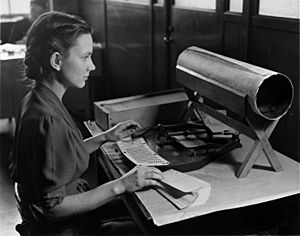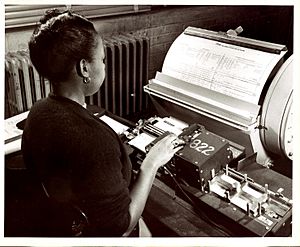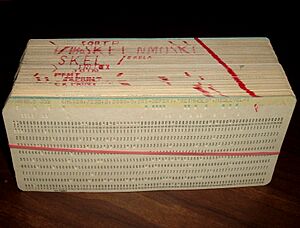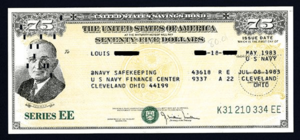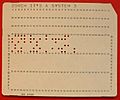Punched card facts for kids
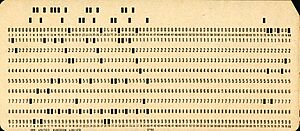
A punched card (or punch card) was a piece of stiff paper used to store information for machines. The information was represented by holes punched in specific places on the card. Think of it as an early and simple way to "talk" to a machine.
Before modern computers, punched cards were a huge deal. They were used for everything from counting people in a census to running businesses and doing scientific research. The idea started with machines like the Jacquard loom, which used cards to weave complex patterns in fabric. Later, an inventor named Herman Hollerith used them for the 1890 U.S. Census, which led to the creation of the company that became IBM.
For most of the 20th century, punched cards were the main way to input data, store information, and write programs for early computers. The most famous type was the 80-column card made by IBM. By the 1980s, they were replaced by magnetic tapes and computer terminals. However, punched cards are still remembered as an important symbol of the beginning of automation and the history of computers.
Contents
History of Punched Cards
The idea of using holes to control machines and store data was invented several times throughout history. Often, inventors didn't know that someone else had already had a similar idea.
Early Ideas
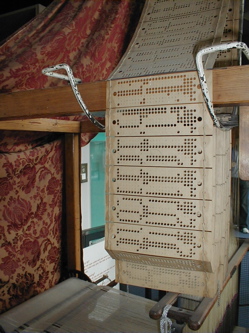
In 1725, Basile Bouchon used a roll of punched paper to control a loom, a machine for weaving cloth. His idea was improved by others, but it wasn't until 1804 that Joseph Marie Jacquard created a fully automated loom. Jacquard's loom used a chain of connected punched cards. Each card told the loom which threads to lift, allowing it to weave very detailed patterns automatically. This was a major step in automation.
Around 1832, Semyon Korsakov in Russia suggested using punched cards to store and search for information. At about the same time, the famous mathematician Charles Babbage planned to use "Number Cards" to feed instructions into his Analytical Engine, an early design for a mechanical computer.
Hollerith and the U.S. Census
The big breakthrough for punched cards came in the late 1800s. The U.S. government needed a faster way to count the results of the 1890 United States census. An inventor named Herman Hollerith developed a system to record data on cards that could be read by a machine.
His machines, called tabulating machines, would pass an electrical current through the cards. Where there was a hole, the current would pass through and complete a circuit, which would move a counter. This made counting the census data much faster than doing it by hand.
Hollerith's success led him to start the Tabulating Machine Company in 1896. After merging with other companies, it was renamed International Business Machines Corporation (IBM) in 1924.
The Age of Punched Cards
From the 1920s to the 1950s, punched card technology grew rapidly. Machines were built not just to count holes, but to sort cards and even do basic math. Companies like IBM, Remington Rand, and others made these machines and the cards they used.
During World War II, punched card machines were used by the Allies to help break secret codes. They were also used for many other tasks, like managing supplies and information.
By the 1950s, punched cards were everywhere in business and government. A common warning printed on cards that were sent out as bills or checks was "Do not fold, spindle or mutilate." This phrase became a well-known saying of the era.
The End of an Era
In the 1960s, new technology began to replace punched cards. Magnetic tape could store much more data in less space. Computers became more powerful and affordable, and interactive terminals allowed people to type data directly into a computer.
By the mid-1980s, punched cards were mostly obsolete. However, their influence can still be seen. For example, many early computer screens were designed to show 80 characters of text per line, the same number of columns on the most common type of punched card.
How Punched Cards Worked
A single punched card could hold a certain amount of information. A stack of cards used for a specific task, like running a program, was called a card deck. The little pieces of paper punched out of the card were called chad.
The IBM 80-Column Card
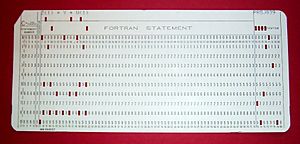
The most famous format was the IBM 80-column card, introduced in 1928. It was the size of a dollar bill from that time, about 7.4 by 3.25 inches.
The card had 80 vertical columns and 12 rows. The bottom ten rows were numbered 0 through 9. The top two rows, called "zone" rows, were rows 12 and 11.
- Numbers: To punch a number in a column, a single hole was punched in the row for that digit. For example, the number 5 was a single hole in the "5" row.
- Letters: To punch a letter, two holes were needed in the same column: one zone punch (in row 12, 11, or 0) and one digit punch (in a row from 1 to 9). For example, the letter 'A' was a punch in row 12 and a punch in row 1.
- Special Characters: Symbols like '&' or '/' were made with different combinations of one, two, or three punches.
To make it easier for people to read the cards, keypunch machines could print the characters at the top of each column as the holes were being punched.
Other Card Formats
While the IBM 80-column card was the most popular, other types existed.
- Hollerith's Early Cards: His first cards for the 1890 census had 24 columns and round holes.
- IBM 96-Column Card: In 1969, IBM released a smaller card that could hold 96 characters of information using tiny round holes. It was used with their System/3 computer.
- Powers/Remington Rand 90-Column Card: This card was clever because it fit 90 characters on a card with only 45 columns by punching two characters in each column.
- Aperture Cards: These special cards had a hole cut out to hold a piece of 35mm microfilm, which often contained an engineering drawing. Information about the drawing was punched on the rest of the card.
Cultural Impact
Even though punched cards are no longer common, they left a lasting mark on culture and technology.
- The phrase "Do Not Fold, Spindle or Mutilate" became a symbol of a rigid, computerized world where people felt like just a number.
- The 80-character line limit from punched cards influenced the design of computer terminals and some file formats that are still in use today.
- Some buildings have designs inspired by punched cards. The windows on the Engineering Research Building at the University of Wisconsin-Madison were designed to look like a punched card.
- During the Free Speech Movement at the University of California, Berkeley in the 1964, students used the punched card as a symbol of the impersonal university system they were protesting against.
Punched cards were a simple but powerful invention. They were a key step on the path to the powerful computers and digital world we live in today.
Images for kids
See also
 In Spanish: Tarjeta perforada para niños
In Spanish: Tarjeta perforada para niños
- Aperture card
- Card image
- Computer programming in the punched card era
- History of computing hardware
- Paper data storage
- Punched tape


